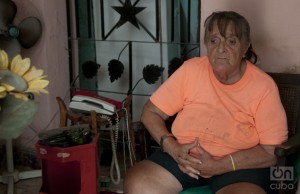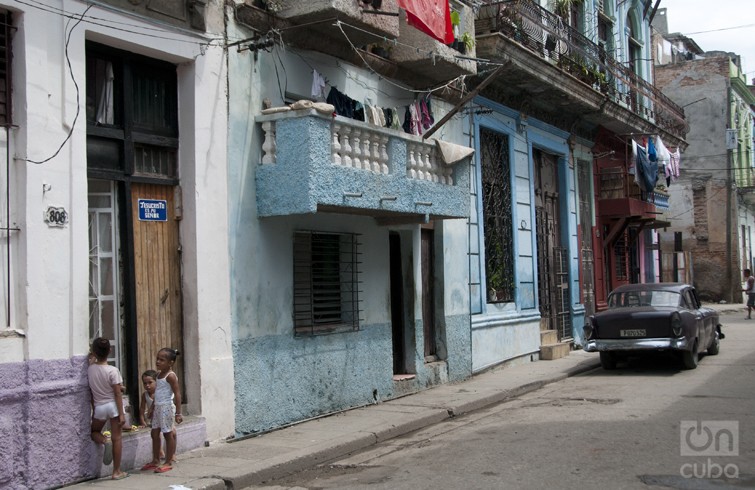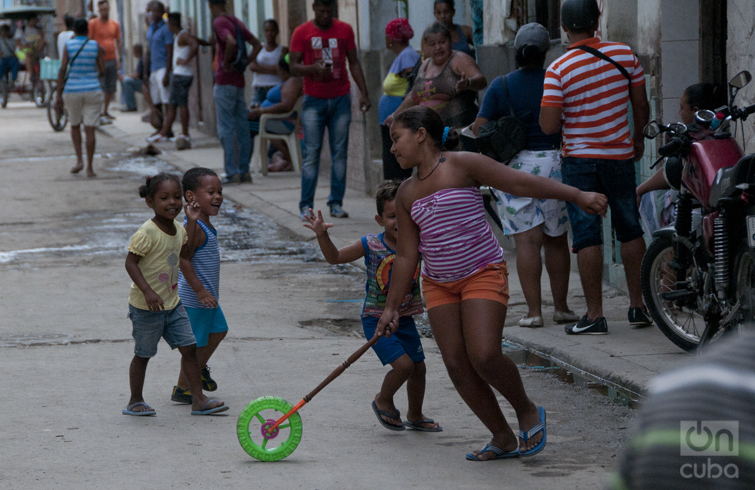Gone With the Rain
By Jorge Carrasco (OnCuba)
HAVANA TIMES — From this balcony, the boys from the neighborhood would jump head-first into the deep river that Gloria street had turned into this past April 29, after 188 millimeters of rain was recorded at the Havana weather station in Casablanca in the course of four hours. Three people died, parts of and entire buildings collapsed and the authorities reported that over ten thousand people were affected by the sudden downpour that in the Cuban capital.
Today, Gloria street is already dry. Children can play out on the street again. The children, still too young to have any sense of the danger or losses, seem to be the only ones who are happy right now.
OnCuba immediately published the stories of some of the people affected by the strong showers that day. We have returned to those places on several occasions to follow these people in their mourning and recovery. Two weeks after the floods and collapses, we return to find out what’s become of these people and what support they have received after a tragedy which, according to Cuba’s Civil Defense Department, left 1,400 homes flooded.
***
On Thursday, May 7, we met with a sad, unsatisfied and angry Patricio Armas, the 81-year-old widower whose wife, Marta Damiana Acanda, drowned on April 29 on Gloria street, between Rastro and Carmen streets. Two weeks after the death of his wife and the loss of the few household appliances he owned, no social worker or Civil Defense or government official has gone to his home to offer any aid (in addition to the replacement mattress he was given).
Patricio, retired and left with only 143 pesos (around 7 USD) of his pension after paying for his Haier-brand fridge every month, wants financial aid. He wants a new TV where he can “watch the news,” he says. “In all of my years of work, I’ve never once asked for any help from the government. If I ask for it now, it’s because I need it.”
According to some of the people who live on Gloria street and offered their statements, the streets in the area tend to flood before the forecast announces rain. Olga Garcia, who lives on Esperanza street, tells us that, a few months ago, a work brigade arrived in the neighborhood to dredge the sewer lines. Everyone thought the situation would improve. However, the brigade never finished the job and, rather than improve, the sewers became more heavily clogged with the rubble they left behind.
Olga was one of the many people whose food was spoiled by the incident. “The water covered the fridge at my home. The chicken I was saving for Mother’s Day was swimming in the freezer.” According to Olga, on April 30, at around half past one in the morning, government officials brought them a bit of rice and mince-meat that was “cold as a stiff.” “Fire-fighters and the Red Cross have been to the neighborhood, but, beyond asking about the situation of the locals, they haven’t offered any concrete aid. Nothing is being done. Everything remains the same after almost two weeks: the mattresses, the filling, the furniture drying out under the sun, on the sidewalks, the walls still wet and marked by the rainfall.”
***
The government’s response to the situation that arose following the intense rains of April 29 has primarily consisted in selling mattresses to those affected and offering food to those who still do not have the means of cooking.
An individual mattress costs 650 pesos (32.50 USD). The price of kind-sized beds was initially announced at 950 pesos (47.50 USD), but, on arriving at the Craft and Hardware Markets (MAI), where they were being sold people found out their real price was 1,900 pesos (95 USD).
At 3 pm on Friday, May 8, 15 people stood outside the MAI located at the intersection of Monte and Angeles street, waiting for the store to open. Many of those who’d been waiting there since 6 am to join the long line-ups that have been forming since the sale of mattresses began grew tired of waiting and left, as there was a power-cut in the area and the store didn’t open that day.
Barbara Fajardo, who lives on San Felipe street, can buy a mattress at half-price because she is a home keeper. Pensioners also benefit from the discount, and indigents can obtain them for free. Families who do not have the cash to pay for the mattresses can purchase them through the bank, on credit. For many, this becomes a real problem, particularly if they’re also paying for household appliances like television sets and refrigerators.
The most serious issue does not appear to be the price of the mattresses or the slow and rather indolent way in which the damage caused by the floods have been addressed. The greatest problem appears to be pointing in two main directions. The first is the underprivileged and poor nature of those who will barely manage to replace what they lost, of people who weren’t doing well at all even before a single drop of water fell on their homes. The second is the insecurity that prevails in the area, for, if similar rains were to fall, the incident could repeat itself. As we know, Havana’s drainage system is not as efficient as is required.
***
In Havana, the grave housing deficit and the slow recovery plans that tend to follow a disaster turn most of those affected into chronically ill patients. Those who lose their homes can spend the remainder of their lives in State shelters, or, in the best of cases, they may have to wait years before a home is assigned to them.
The cooks at the “Ten Cent” Bar located on Suarez street, between Corrales and Monte, refer to those affected by the rains of April 29 as the “new ones.”
For those who aren’t familiar with the establishment, at three in the afternoon on a Thursday, the “Ten Cent” bar is a hot, sweaty, foul-smelling place full of alcohol and crude-spoken men, a place of darkness and noise. The neighborhood’s decadence is concentrated there, precisely the place that should be a shelter for those in need of aid.
Juana Alma, who has been working at this State establishment for nearly 10 years, has become used to dealing with the victims of disasters. According to her, some people have been living in State shelters for more than 20 years and still need to eat there, not having their own means of cooking a meal.
From the night of April 29 to lunch-time on May 2, employees at this establishment received over 270 people affected by the rains. The victims of the disaster complained about the poor quality of the food. At 61 Factoria street, where nine apartments collapsed on the afternoon of the 29th, we met with Isabel Gonzalez, who explained to us how they managed to get their food during the first days following the flood.
“The food they gave us at the “Ten Cent” Bar was a bit of yellow rice with spoiled bits of fat and half-boiled potatoes. I’d rather buy a pizza out on the street than eat that,” she says.
Yaremis Kindelan, the mother of a five-year-old girl who was watching television when their home collapsed (and miraculously survived) spoke to us one week after the tragedy. “They haven’t even given the children any milk. And we have pregnant women here.”
Last Friday, in the vicinity of Factoria street, a crane was lifting the rubble of what was once the home of Yaremis, Isabel and other tenants. Occasionally, one of them would turn around to watch the crane’s heavy metallic claw scoop up the rubble. At this point, the crane must have already left the area clean. Later, they will likely install two or three wrought-iron benches and a seesaw there, and set up a park.
***
We came across Jessica, the eldest of 71-year-old Ernestina Ulacia’s granddaughters, sitting on a wooden, leather-backed stool set in front of the remains of 110 Florida St. The home where her mother, grandmother and sister lived collapsed after an old, uninhabited building on Alambique street (a building that has been threatening with collapsing for nearly 45 years) fell on top of it.
Enestina Ulacia was hospitalized the same day the building collapsed. She was trapped beneath the rubble and fractured several bones, including a hip. Her family has temporarily moved to the home of relatives on Puerta Cerrada street. Ernestina underwent an operation and is now awaiting a skin graft for one of her legs.
Some of her belongings are still under the rubble of what was once her home. A neighbor boarded off the remains to prevent these from being “scavenged.” “They gave us two mattresses and offered to take us to a shelter in Arroyo Naranjo, on the outskirts of the city, but considering the condition my grandmother will come out of the hospital in, we can’t move to a shelter,” Jessica tells us.

Maria Luisa Iglesias, 70, is the head of neighborhood watch in the area. “In cases like this,” she explains, “the Committee for the Defense of the Revolution (CDR) normally works to give the family an uninhabited house in the neighborhood, but neither of the two available have a roof and they are both in very bad shape.” When we went to Florida street a second time to ask about Ernestina, she saw us arrive from the door of her house and sent someone to take us there, wanting to speak to us.
The condemned building that fell on top of Ernestina’s house is still there, she tells us. They haven’t come around to tear it down completely. Maria Luisa tells us that, in 1970, they evicted the building’s tenants for the first time, owing to the risk of a collapse. Other locals fear that concrete giant will collapse again on top of their homes, as it did on April 29.
Jessica also believes that, when the remains of the building finally come crashing down, they will crush everything below. What she is afraid of now is for a strong rain to come down again. Her fear is almost inexplicable, considering her home has suffered the worst of it already. She expresses a fairly widespread feeling: even those who have nothing more to lose fear the day’s weather forecast.











The part that pissed me off the most is that a tourist from Vermont will arrive at the airport in Burlington from their two week vacation in Cuba and tell the folks at the airport how “quaint and charming” the old cars in Cuba are. They will then drive away in their 5 year old Volvo and complain that they need a new car.
The communists in Cuba – a minority – are only too happy to utilise anything they can get from the Western World but deny the non-communists access to the internet (a British invention). As the major cause of death in Cuba is cancer, we ought to be able to anticipate a reduction as a consequence of the “Cuban lung cancer vaccine”?
By your comment, it seems that it is you that live in a bubble. A failed leftist bubble. You should re-examine who your “Daily Worker” really is. He doesn’t work in a factory anymore. He works in an office. And he is probably a she or a person of color. Your whole anti-US, anti-capitalism shtick doesn’t carry the weight it used to. Union membership is down and yet Democratic party membership is up. Take off your Che Guevara t-shirt. People are wearing Google t-shirts today.
OMG ….No Moses, No!!!! You mean no longer will I be able to ride a 55 Ford truck cab pulled by a mule?!
Moses, what bubble do you live in ? This is 2015, not 1955. By now, the issue of wealth concentration, how it occurred and what it is doing to society, has long left the pages of the Daily Worker, and is featured everywhere you look. You seem oblivious.
My point Dan is that some of the wealthiest people in the US/world created products you use every day. No need to hold a grudge against them, Since you dont use Apple products you must be on a windows desktop. The money you invested in the computer and software went into the pockets of Bill Gates. Does that bother you?
And before we use any “vaccine” the FDA needs to run some serious testing. Let’s see if it’s true…doubt it but you never know
I don’t hate or distrust rich or successful people simply because they are rich or successful. By your comment, it seems that you do.
Plutocrats and honest labor in the same sentence ??
I don’t know what your answer has to do with anything, and I guess by this reasoning, only Communists in America should use the Cuban lung cancer vacine if it is approved here, but for your info, I’ve never been on Facebook in my life ,nor had an Apple.
People like Dan want Cubans to continue to live in the Dark Ages. As relations warm with Cuba, their biggest concern is that Cuba risks being “spoiled” by modernity. These days that may mean a Walmart and a McDonald’s. Ojalá Cuba could remain a cozy little islet where leftist fanatics could go for pleasure trips back in time but Cubans deserve convenience too. Besides, Cuba once free, may possibly learn from the mistakes made by others in the 20th century and grow forward another way. One can only hope. …
Perhaps Dan should give up his Facebook account and stop using his windows and apple products. That way he can stop supporting these eel companies
To be clear, I would never begrudge anyone for living well from the fruits of honest labor. My dander is up because this man (and his wife) spout that egalitarian bullsh*t and all the while behind closed doors live a cushy life. Their hypocrisy gags me.
I think you are correct about Cuba being egalitarian. With the exception of the Castro family regime and its immediate henchmen (not many women), the rest of the people of Cuba are able to enjoy equality – most have incomes within $12 of the monthly average of $20, (from the $8 pension to the $32 for a school principal). Perhaps only North Korea rivals the level of equality.
Strange. You vigorously defend a system which has resulted in the world’s 80 most wealthy individuals having as much as the combined wealth of the bottom half of humanity. But you rail on about $500 differentials between the net worths of Cubans. I don’t like to see it either, but Cuban remains one of the most egalitarian countries I have ever seen.
I know a Cuban ex – funcionario who served many years in the Cuban embassy in Colombia and in Nicaragua. Just before he retired a few years ago, he ordered a Sealy Posturpedic mattress through contacts in the US embassy and shipped it to Cuba duty-free. This same ex-diplomat, who is otherwise a very decent old man, extols the virtues of the Castro regime while watching TV on his 50-inch flatscreen. He swears by Cuban coffee but he uses a $500 German-made coffee maker he got as a gift when he left the Nicaragua mission. He gripes about the influence of American culture in Cuba yet he listens to Frank Sinatra all day long. Stories of despair like the ones told in this post don’t reach his ears. He lives in that space reserved for the Castro dictatorship elite.
Sure Carlyle, Socialism, the one word you seem to know in Spanish, is to blame for the less than adequate response to this natural disaster. Experts around the word who work in this field and foolishly praise Cuba’s readiness and efficiency in responding to these crisis, are mislead. That’s why Katrina was so pleasant for the poor of New Orleans, and Haiti and Honduras are such safe places to be in a storm. No Socialismo.
A wonderful descriptive article which records the reality of the achievements of fifty five years of Socialismo. This is a measure of the Castro family regime. Everybody in equal levels of squalor. Cuba continues to crumble.
In our city, people cannot afford the new mattresses described. I know of three people whom earn there livings by going to peoples homes to dismantle mattresses and then re-stuff them with the original rag stuffing. The outer springs are moved to the centre and the centre ones to the outer parts and the outer cover is patched. It takes one day per mattress.